The Story of the 22B
By modern standards, Subaru are a small vehicle manufacturer. The company was started in 1958 and is predominantly owned by Fuji Heavy Industries, a major Japanese industrial company.
For years, Subaru cars were the choice of farmers, throughout the world. The tough build quality and excellent four wheel drive system made them ideal for use on the land. It was not until the 1990’s that the excellent design and low centre of gravity of the flat four boxer engine, together with its symmetrically equal length drive train, began to be fully exploited in motorsport.
A young Colin McRae started his Subaru years in a Prodrive prepared Legacy Turbo and his success gave feed back to FHI for the design of the Impreza Turbo, or WRX as it is known in the southern hemisphere. What happened after that is legend and 1995 saw McRae and Derek Ringer become the first ever British World Rally Champions. Subaru have since taken the constructor’s title in all but one of the following years, with 1997 heralding the Peter Stevens designed Subaru Impreza WRC car on the world’s stages. All WRC drivers still today acknowledge this car as the most beautiful entrant in the WRC line up.
Although BAT failed to renew their sponsorship of the team at the end of 1998, the 555 years will always be remembered in motorsport. On any World Rally event, the crowds would be full of blue and yellow clothed fans. The 1999 and 2000 cars have retained the Sonic Blue and yellow livery although now with the Subaru “swoosh” and their lines and colour draw breath from all who see them in the flesh. Either for the first time, or the hundredth time. In 1998, Subaru declined a lucrative sponsorship deal, as it would have meant losing the Sonic Blue colour. Subaru Technica International, FHI’s in-house tuner, provided the bulk of the funding for the team.
1998 marked 40 years of Subaru and the marketing people in Japan wanted to celebrate the company’s success with a car like no other.
So was born the 22B.
The name itself is an enigma. Many journalists jumped to the mistaken assumption that 22 referred to the 2.2 litre engine and the B stood for Bilstein, the car’s suspension manufacturers. The truth is 22B is hexadecimal (number base 16, used in the coding of computer programmes where the letter A to F are used for the numbers 10 to 15) for 555.
To prove this, take a calculator and add the following into the memory…
2x16x16 = 512
2x16 = 32
B = 11
Total = 555
The technical specification of the car had to be a list of superlatives and the engineers at Subaru and Prodrive let their imagination run wild.
The engine was bored out to 2.2 litres, retaining the same stroke as the stock 2.0 litre engine. This had the effect of giving the car a torque curve that wasn’t even a curve. It is a steep climb and table like flat line, when plotted on a graph. The increase in mid range performance gives the car 70bhp more than its 2.0 litre brothers, at only 3,000 rpm. Such was the mid range power, that many respected journalists embarrassed themselves by stating that the car must produce over 350bhp. No 22B has broken the voluntary power limit, in standard form.
Although the engine still complied with the Japanese voluntary power limit of 276bhp, it is how and where it delivers this power that is so enjoyable… and the 22B delivers usable power like no other modern car. Its turbo is a large IHI VF23 roller bearing unit, providing huge volumes of compressed air, but with very low inertia properties. Its fuel rails are custom units, required to match the demands of such a highly tuned engine and the pistons are forged lightweight units, so as to minimise the weight of their 98mm bulk. Transmission is via the same gearbox as the STI IV type R, incorporating the driver adjustable viscous centre differential. The front and rear track were increased by 40mm and 80mm respectively. This was partially achieved by using BBS 17x8.5” wheels and by redesigning the rear suspension arms and driveshafts.
Most of the mechanical parts of a 22B are stock items on other Subaru cars, the 22B just uses the best of what was available. But the most interesting part is the shell.
Every car was hand made, starting with a lightweight 2 door WRX RA shell and then cutting off the rear arches. The new “blown” arches were welded in their place and the front of the car received similar appendages to cover to massive wheels and extra track. The dimensions of the car were now virtually identical to the car watched by millions, in the hands of Subaru’s new driver line up, Richard Burns and Juha Kunkkenhann. The rear spoiler has the same adjustable foil as the WRC car, for increasing down force on twisty tarmac events.
The brakes fitted were the standard Subaru 4 pot calipers with 292mm discs on the front and a new rear 2 pot caliper with larger vented disc on the rear. Both were painted in a bright red colour, looking very distinctive through the gold BBS wheels.
The car’s Bilstein suspension is the only part of the car that has not received universal acclaim, being designed for the smooth fast highways of Japan rather than the undulating B roads of Europe. Although the dampers carry a badge which says By Prodrive, Prodrive were quick to say the final spec was actually decided in Japan.
The interior of the car features a matt finished dash layout and specially embroidered seats. In front of the gear lever, a plaque denotes which of the initial 400 cars this particular one is.
I say initial as more than 400 were produced. A total of 426 were finally made. 3 cars are designated 000 and are owned by Colin McRae, Nicky Grist and David Lapworth, there is no number 13 and 24 cars were made for issue outside Japan. Of this 24, 16 came to the UK and were badged 22B Type UK and the other 8 went to the owners of Subaru concessions throughout the world. It is rumoured that a few of this final 8 went to private collectors, such as The Sultan of Brunei.
At the time of writing, I am very lucky to have driven 24 different 22B cars and doubt that anyone outside of Subaru has been so privileged. My most memorable time was when Anders Skarsten handed me the keys of his 22B for me to use on the 1998 Tour d’Ecosse. Just over 2000 miles of driving, half of this spent on the fantastic roads of Scotland’s west coast.
Every 22B I have driven has been different, each reflecting the hand built nature of the cars. Every one has brought a devilish smile to my face and envy of the fortunate owners, who enjoy the amorous glances and dropped jaws of the public on a daily basis.
Dimensions 4365 x 1770 x 1390mm
Tread Front / Rear 1480 / 1500mm
Vehicle Weight 1270kg
Engine 2.2 litre Boxer Master-4 DOHC Turbo
Displacement 2212cc
Bore x Stroke 96.9mm x 75.0 mm
Compression Ratio 8.0 to one
Cylinder Block Aluminium Alloy Closed Deck
Cylinder Head Aluminium alloy, dohc per bank,
4 valves per cyl, turbocharger, metal gasket,
Inner shim valve lifters
Pistons Molybdenum coating low-friction pistons
Intercooling Intercooler auto water-spray system.
Cooling STI Radiator
Fuel and ignition Multipoint fuel injection
and ignition
Max Power 276 bhp @ 6000rpm (280PS)
Max Torque 265lb ft @ 3200rpm (37kg-m)
Transmission 5-spd manual, four-wheel-drive, sintered twin clutch, shot peened gears.
Rear viscous LSD (2-way 4-pinion)
Driver controlled center differential
Gear Ratios 1st 3.083
2nd 2.062
3rd 1.545
4th 1.152
5th 0.825
Reverse 3.416
Final Drive 4.444
Super-quick shift linkage
Suspension Bilstein Strut and Eibach coil springs Front carbon strut tower bar Aluminium front lower arms
Steering Super Quick Power Steering Gear Box(13:1) with power steering fluid cooler
Brakes Vented discs front and discs rear
Wheels 17x8.5JJ BBS Alloy Wheels & Carbon Centre Caps
Tyres 235/40 ZR17 Pirelli P Zero
Body WR car-type front grill and bumper
WR car-type STi foglight cover
WR car-type body coloured side skirts
WR car-type rear bumper
WR car-type adjustable rear wing with brake light at boot level.
Aluminium Front Bonnet.
Cherry Red Front Grille Emblem (6 stars)
Front & Rear Sticker (22B-STi)
Coloured coded side under skirt, rear spoiler, bumper and front spoiler
Interior Brushed aluminium instrument panel cover
Auto air-conditioner
Brushed aluminium front console
Steering Wheel Nardi shock absorbent leather (without Air Bag)
Seats Original design Suede (Artificial) Front Bucket Seat & Rear Seat
Serial Plate Serial Number Plate<000/400>
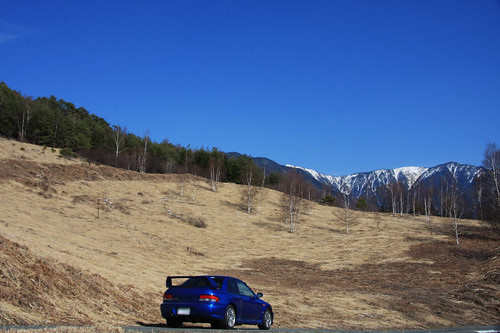
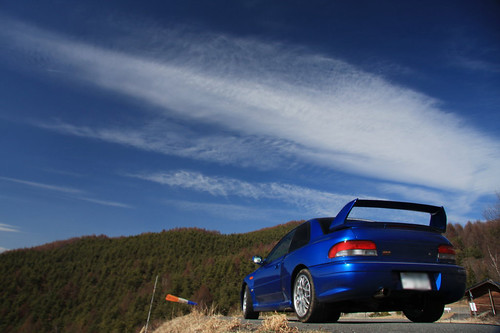
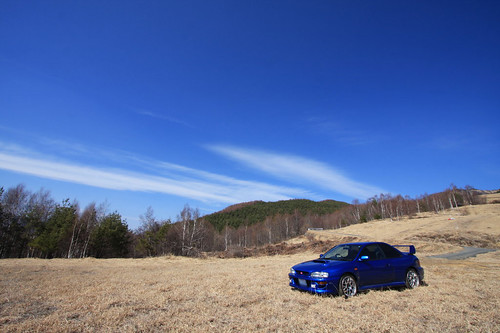
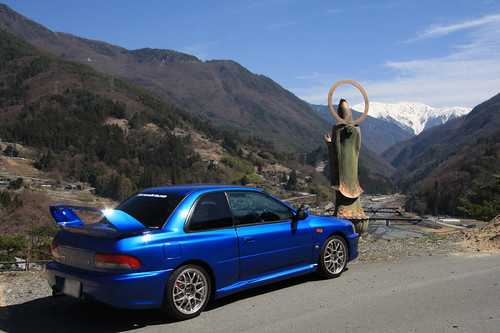

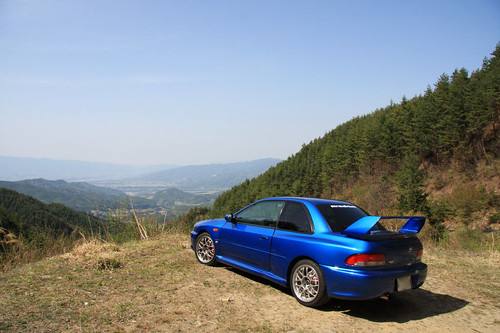

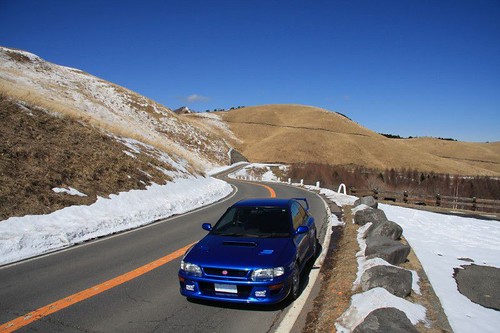


waaah the entire concept is such a work of art!
ReplyDelete